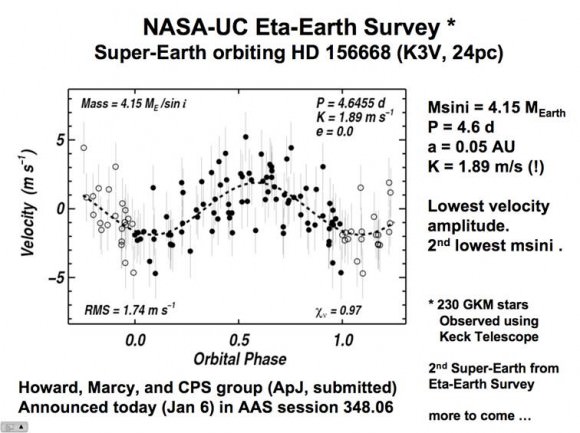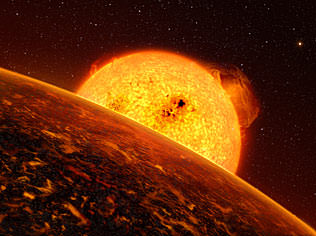[/caption]
Planet hunters have detected an extrasolar planet that is only four times the mass of Earth, making it the second smallest exoplanet ever discovered. Astronomers using the 10-meter Keck I telescope at the Keck Observatory in Hawaii found the un-poetically named HD156668b, which has a mass of roughly 4.15 Earth masses. It orbits its parent star in just over four days and is located roughly 80 light years from Earth in the direction of the constellation Hercules. This adds to the growing list of so-called “Super-Earths” now being found.
“This is quite a remarkable discovery,” said astronomer Andrew Howard of the University of California at Berkeley. “It shows that we can push down and find smaller and smaller planets.”
The researchers used the radial velocity or wobble method, using Keck’s High Resolution Echelle Spectrograph, or HIRES instrument, to spread light collected from the telescope into its component wavelengths or colors. When the planet orbits around the back of the parent star, its gravity pulls slightly on the star causing the star’s spectrum to shift toward redder wavelengths. When the planet orbits in front of the star, it pulls the star in the other direction. The star’s spectrum shifts toward bluer wavelengths.

The color shifts give astronomers the mass of the planet and the characteristics of its orbit, such as the time it takes to orbit the star. Nearly 400 planets around other stars were discovered using this technique. But, the majority of these planets are Jupiter-sized or larger.
“It’s been astronomers long-standing goal to find low mass planets, but they are really hard to detect,” Howard said. He added that the new discovery has implications for not only exoplanet research but also for solving the puzzle of how planets and planetary systems form and evolve.
Astronomers have pieces of the formation and evolutionary puzzle from the discovery of hundreds of high-mass planets. But, “there are important pieces, we don’t have yet. We need to understand how low mass planets, like super-Earths, form and migrate,” Howard said.
The goal of the Eta-Earth Survey for Low Mass Planets, which was the brainchild of fellow planet hunter Geoff Marcy, also from UCB, to find these super-Earths. So far the survey has discovered two near-Earth-mass planets with more are on the way, Howard said.
Other collaborators included , Debra Fischer of Yale University, John Johnson of the California of Institute of Technology and Jason Wright of Penn State University.
The discovery was announced at the 215th American Astronomical Society meeting in Washington D.C.
Source: Keck


Fantastic! Any idea what type of star this exoplanet is orbiting? I would imagine that with an orbiting cycle of a bit over 4.5 days, this exoplanet is very close to it’s host star, tidally locked, and extremely hot. Exciting news, 2010 is starting out with a bang in terms of exoplanet discoveries.
Yep, the planet is a lava planet, maybe with an atmosphere of vaporized rock or silicon. Not a really nice vacation spot, unless you like lava spas. It is also tidally locked. It makes you appreciate the little oasis we find ourselves on.
LC
William928, it’s a K3V, says so in the title caption of the slide. So cooler than the sun, but probably still hot enough to make at least the starward pole a lava ocean.
Assuming a rock, that’s something like 1.5 Earth radius. This is starting to feel like home territory!
Btw, somethings off. This planet has now been posted in the Extrasolar Planets Encyclopedia as #6 in low mass. Which means that when I take out the 3 pulsar exoplanets people want to forget for no apparent reason [OK, one is _really_ puny – but the other 2?], there’s still 2 lower mass.
What’s up with that?
The EPE postings are vetted (since the total number at times goes down, likely exoplanet observations are revoked when necessary). So is there a debate on one of those 2 lower mass planets? Does anyone in the know know?
First planets were discovered by Wolszczan and Frail as long ago as in 1992. From the beginning most people, including majority of astronomers are ignoring the fact. Usually the only hint of their existence is given in some articles by the phrase
” found around the main sequence star” or
“around a normal star”
I gather then, that Nancy should have written it as follows:
Planet hunters have detected an extrasolar planet that is only four times the mass of Earth, making it the second smallest exoplanet ever discovered around a main sequence star.
Once I’ve got an opportunity to ask a prominent radioastronomer what he thinks about it. He was personally against the idea, he doubted the discovery saying that really noone knows what is going on and what causes the disturbances in the pulsar, he personally believes it is caused by sliding magnetic fields but he also admitted the fact that Wolszczan’s planetary theory is the simplest one and describes the pulsar disturbances in the best way. All other theories are much more complicated and do not fit the data as well as in the case of Wolszczan’s one.
I assume because of it there is no debate because noone can explain it better or at least as well. The majority don’t like the idea but has no means to refute the Pulsar planet discovery so almost everybody silently ignores the facts and pretends that nothing happened . Probably this discovery is a kind of one which is too hard to accept for majority of astronomers nowadays.
Spacerius [sic?], thanks, now I understand more of why the pulsar planets are set apart.
There are now plenty of other exoplanets and planetary disks and their models. At a guess it would be less surprising that neutron stars can accrete a new generation of smallish planets from the supernova remains. Still, there is history involved.
Spaceriuss,
In your previous post (concerning the pulsar-planetary system PSR B1257+12) you wrote “The majority don’t like the idea but has no means to refute the Pulsar planet discovery so almost everybody silently ignores the facts and pretends that nothing happened . Probably this discovery is a kind of one which is too hard to accept for majority of astronomers nowadays.” Who were you referring to? Much work has gone into studying this peculiar (though not unique) system in the years since its discovery. A third planet was discovered in 1994 and a possible ‘dwarf planet’ was first detected in 2002 (estimated mass 0.00004 Earth mass!). I can’t see any professional astronomer ignoring this or any similar object because “its too hard to accept”. This system was the first planetary system found outside our own Solar System, after all. Possibly you are referring to press releases and popular news accounts, which may fail to discuss this system explicitly simply because of the audience the press release is aimed at.
Besides PSR B1257+12, at least one other pulsar planet is known (PSR B1620+26) and a protoplanetary disk was revealed around the magnetar 4U 0142+61. And the search goes on. Check out, for starters, the Wiki ‘Pulsar Planet’ page: http://en.wikipedia.org/wiki/Pulsar_planet .